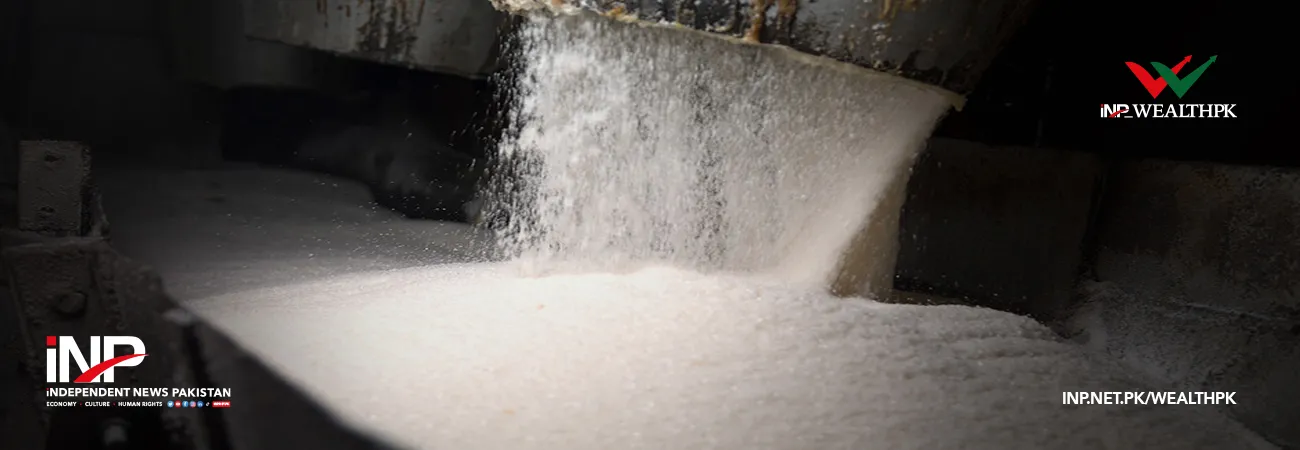INP-WealthPk
Faiza Tehseen
Chinese cooperation to establish high-grade sugar production units in Pakistan is important to improve sugar exports. It will also strengthen the agricultural sector and local sugar industry, President Pak China Joint Chamber of Commerce and Industry (PCJCCI) Moazzam Ghurki told WealthPK. He said the PCJCCI wanted experts and business communities from China and Pakistan to join hands in this concern. He also emphasized popularizing tissue culture for high yields of sugarcane. Only a healthy and good outcrop can lead to good sugar recovery, he said and emphasized getting more cooperation from the Chinese Academy of Tropical Agriculture Science (CATAS). The CATAS is training scientists across the globe, and Pakistan should acquire more coordination for tissue culture. High yield of sugarcane is the first step to produce sugar, added Moazzam. Talking to WealthPK about sugarcane production and establishing HGS units with the Chinese coordination, Chief Scientist Sugarcane, Punjab Dr. Muhammad Zafar opined that advanced technology for sugar production was direly needed in the country. Besides the adoption of technology, sugarcane production is also important, he added. “It takes about 12-13 years to introduce a sugarcane variety.
If we import the sugarcane and do the adaptation, it takes less time. The Chinese and Brazilian varieties in Pakistan are in the first year of their trial, while the successful Australian variety is in the process of approval,” Zafar said. “The ratio of juice recovery from the sugarcane is a controversial thing. It is a tropical plant. But in the coastal areas of Sindh like Thatta, Badin, or Sujawal, its production is far less than the actual potential. The recovery ratio in different parts of Pakistan differs from 8% to 8.55% or 9%, except in Punjab where it is 12% or a little more. “Sugarcane yield is far better in Punjab. It is 71 to 72 tons or 822 maunds per acre, while the other parts of the country produce 70 tons per hectare. It can be increased with our varieties in other areas if the farmers follow our instructions,” he added. The Pakistani sugar has 99.9% sucrose. Western countries mostly produce brown sugar with 70 to 80% sucrose that is not harmful to the pancreas. So, people become less diabetic. Globally, ethanol is also produced for use as biofuel. Concluding the discussion, he said the government should take the initiative in establishing the HGS units in Pakistan.
Both brown and white sugars could be produced from a unit. The export of our refined sugar is already good and profitable, and the HGS units will add more value to it. Sharing views with WealthPK about the need for establishing the HGS units with the Chinese coordination, Dr. Rashid Ali Baloch, HR and Administration head at the Khairpur Sugar Mills, Sindh, said it was a good step to take that will enhance the export of quality sugar from the country. “For the establishment of HGS production units in Pakistan, a few aspects are important to be kept in mind. First of all, the overall production to feed the mill. Second, a proper mapping of sugarcane-rich areas to assess the number of HGS units in a specific area, and the production cost. The existing units can also be upgraded to produce HGS. It will help make a cost-effective start. Discussing in detail, he said the cane-crushing capacity of sugar mills in Punjab was about 15,000 to 16,000 tons per day, but a few, such as Hamza Sugar Mills, had the capacity to crush 20,000 tons of cane per day. In Sindh, the regular cane crushing capacity is not more than 10,000 to 12,000 tons per day. This shows that about 300,000 maunds of sugarcane are crushed daily while each mill crushes around two crore maunds annually.
In the 80s, the sugar mills would operate up to May and June, but due to the change in the seasonal cycle, the mills now run for four months, mostly from Nov. 15th to mid of March. According to the Sugar Cane Act, crushing must start in October, but sucrose is delayed to develop in the cool weather. Before the weather gets cool, sugarcane produces less sucrose. As a result, sugar production decreases. “Normally, seven kilogramme sugar is recovered from 100kg (2 ½ maunds) sugarcane. Suppose the price of 7½ maunds of sugarcane is PKR1,062, excluding the cost incurred on manufacturing, processing etc. Now, considering the market selling rate is PKR 130 to 140 per kilogram, even if the mill sells its product at this rate and makes a profit of PKR 15-20 per kilogram, it still experiences losses. This is why harvesting the sugarcane at the end of November is preferred to extract more sucrose to get 10kgs of sugar from 100kgs of juice,” he explained. After March, the sucrose level starts decreasing again. This is the reason that the mills remain active up to the middle of March. It will be a good step to get advanced technology with Chinese coordination, but it is also important to discuss the option of upgradation of the existing units with them, added Dr. Rashid Ali.
Credit: INP-WealthPk













